The use of iodine for tomatoes
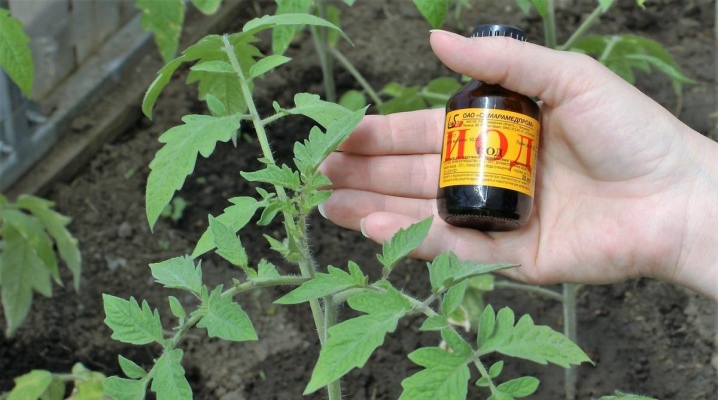
Tomatoes, for all their demanding care, are a favorite culture of almost all gardeners. Of course, at the end of the season, everyone wants to see bright, large fruits on healthy bushes on their site at the end of the season, and not tops eaten by aphids. To do this, the plantings must be monitored and carefully looked after, including competent and timely feeding. Not everyone wants to use chemical fertilizers in their garden. And here homemade recipes come to the rescue. Increasingly, when growing tomatoes, gardeners with experience use iodine - a drug that, when used correctly, does not have a harmful effect either on the inhabitant of the garden or on a person. The substance will provide plants with additional nutrition, help them cope with the mass of microbes and fungi. Its beneficial effect on the development of culture has already been appreciated by many.

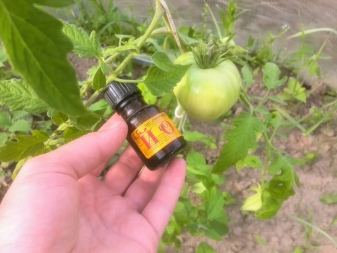
Iodine is inexpensive, this pharmaceutical product has been used by more than one generation of gardeners. But there are controversial issues in working with iodine. Let's talk about this tool in more detail.
What is it needed for?
Pharmacy iodine is an alcohol solution (5%) of a chemical element present, for example, in algae and sea water. In certain doses, it is beneficial for both humans and plants. The beneficial properties of iodine specifically for tomatoes are as follows:
- iodine increases yields, and also improves the quality of the fruit;
- the use of iodine helps to increase the immunity of the plant;
- the ripening period of tomatoes is reduced;
- when feeding with iodine, the number of ovaries increases;
- iodine facilitates the assimilation of nitrogen in the soil and air by tomatoes and can replace, for example, saltpeter;
- helps to fight aphids, ticks and other pests;
- the color of the tomatoes becomes uniform;
- the plant's resistance to temperature extremes and high humidity increases.
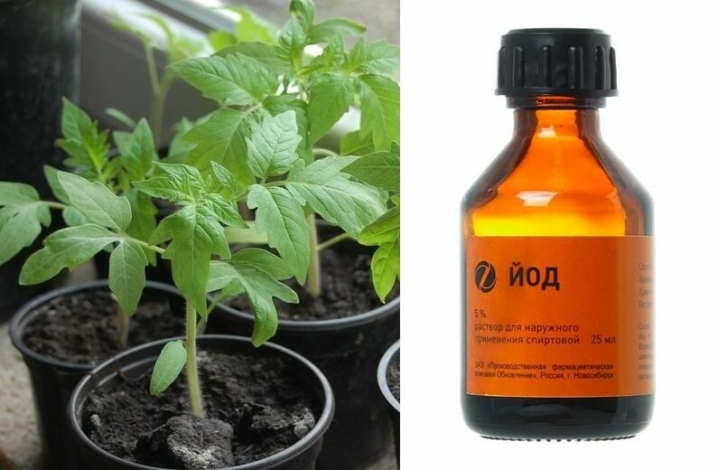
Some of the beneficial effects of using iodine for feeding, fertilizing and treating tomatoes are worth dwelling on. The first time you should think about the use of iodine is the appearance in plants of signs indicating its lack. One of them is that tomatoes that have already entered the final period of life cannot ripen.
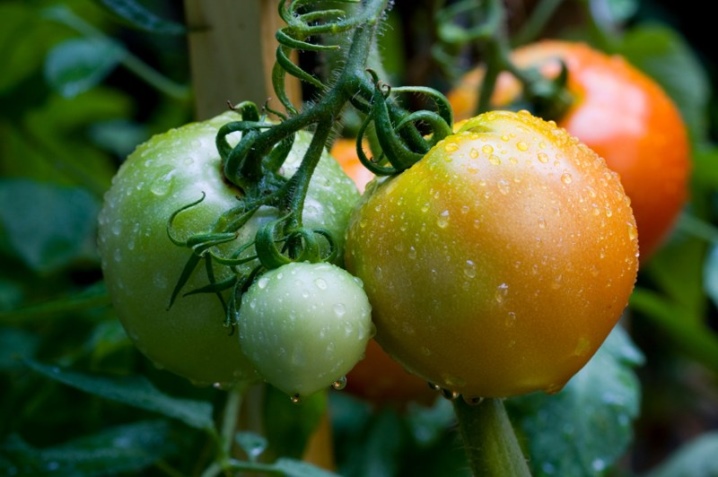
Another sign is a clear decrease in plant immunity. This is especially dangerous for the "youth" living in the garden. Seedlings may simply not have enough strength to fight diseases. Iodine also helps to disinfect the soil. It is effective in combating mosaic, root rot, brown spot and late blight - one of the most dangerous tomato diseases that can rob you of your entire crop.
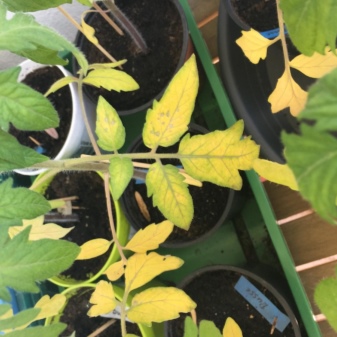
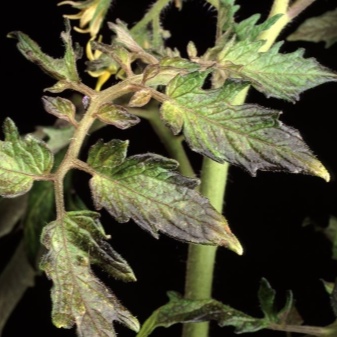
Late blight is more typical for plants grown in a greenhouse. This is a fungus, respectively, it multiplies by spores that are easily carried by water, wind, love moisture and have a high frost resistance.
The reason to raise the alarm is the appearance of brown spots on the leaves and stems. Other symptoms: blurry brown spots under the skin of the fruit and white bloom on the underside of the leaf after rain.
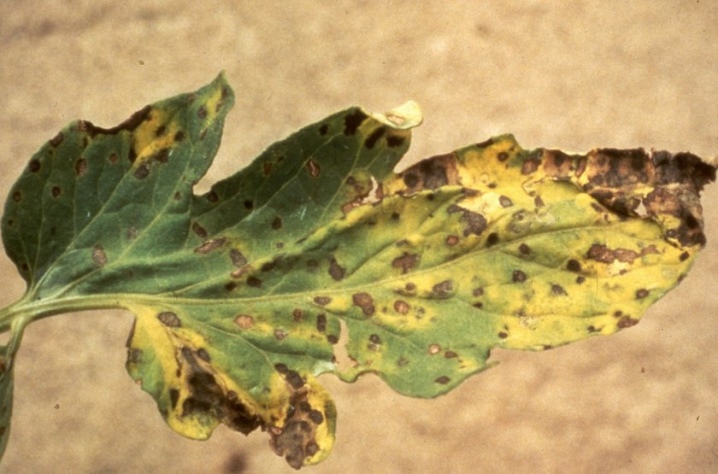
A sore appears on tomatoes in the third decade of July. Fighting late blight is like waging a constant war, since it is almost impossible to destroy spores. Iodine, which kills these spores, can become the gardener's main assistant in this struggle. Greenhouses should be treated with iodine in the spring, when the air temperature reaches +10 degrees - this is when the spores are activated. Using iodine to disinfect the greenhouse will help keep waste to a minimum.
How to breed?
In order for iodine to benefit your garden, it is necessary to dilute it correctly, observing the proportions. There are several recipes. Remember - it is impossible to increase the dosage of iodine in any case!
Recipe number 1
A drop of iodine is required for 3 liters of warm water. Such a solution is used only on wet soil, if used for seedlings with fertilizer, you just need to moisten the soil a little or spray the bush.
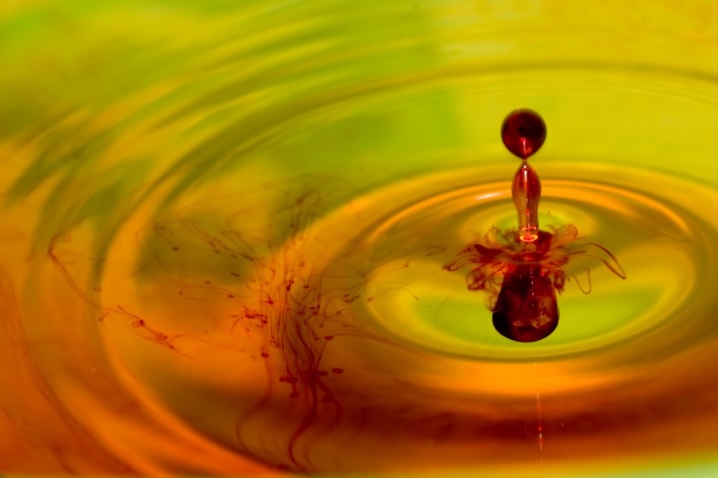
Recipe # 2: For a three-step root dressing
Stage 1: Seedling
To process seedlings, a couple of drops of iodine are diluted in 5 liters of heated water.
Stage 2: When the ovary is formed
5 drops of iodine are added to a bucket of warm water. We fertilize according to the formula: "1 liter of solution - 1 bush." The exception is undersized tomato varieties, which require 0.7 liters per bush.
Stage 3: During fruiting
All the same 5 drops of iodine in a bucket of warm water, plus a glass of wood ash is now added.
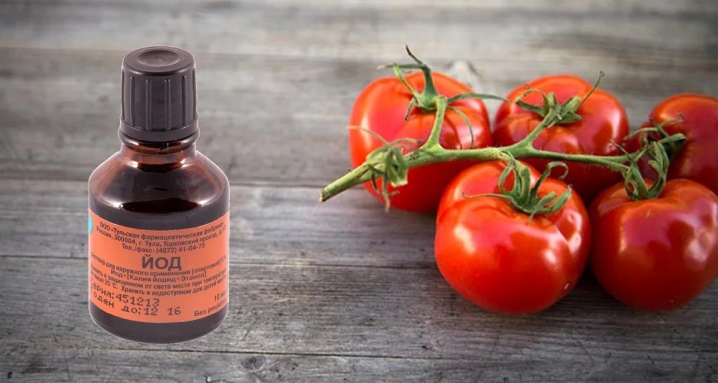
Recipe number 3: To protect against late blight
4-5 drops of iodine per 10 liters of water. The solution obtained in this way must be sprayed on the bushes every 15–20 days. It is advised to insist on any solution for 6 hours. The concentration of iodine should increase only when feeding during the fruiting period, however, the opinions of gardeners differ here, which will be discussed later.
Effective recipes
In addition to using a pure iodine solution, you can use multicomponent home fertilizers and dressings based on it.
With milk
A popular recipe for top dressing of tomatoes. Milk contains a lot of elements that can benefit the plant: magnesium, potassium, phosphorus, etc., and in addition, amino acids that improve the growth of tomatoes. Milk balances the acid-base balance, helps plants absorb nutrients and improves the taste of fruits. Moreover, the acidic environment of milk whey is detrimental to fungi.
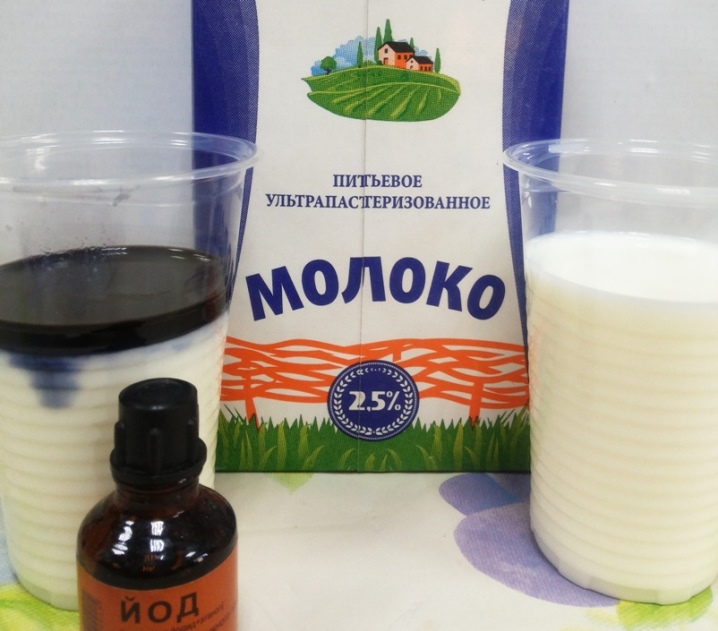
The composition of the base solution is as follows: 1 liter of warm water, 1 glass of milk (not pasteurized, ideally home or farm!), 3 drops of iodine. This mixture is sprayed on the ground parts of the plant. Spraying should be done in the morning or evening, when there is no bright sun. The resulting liquid is used to spray the ground part of the crop.
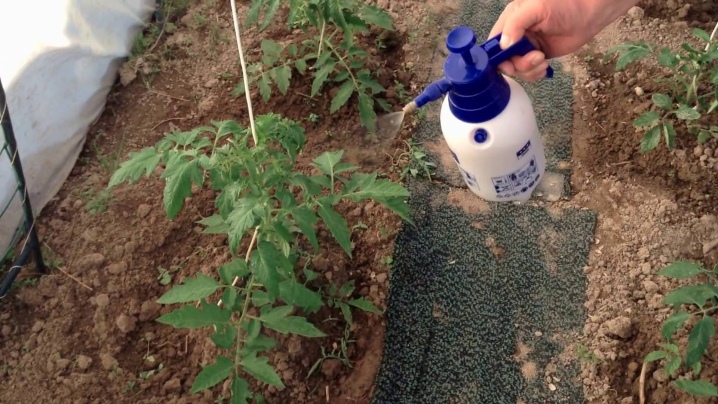
Another well-known recipe with milk and iodine is used if there are signs of late blight. Its composition: 1 liter of whey, 15 ml of 3% hydrogen peroxide and 40 drops of iodine per 10 liters of water. The resulting mixture should be sprayed over the entire plant. In this case, whey acts as a protective barrier, forming a film on the tops.
With boric acid
Another popular iodine supplement is boric acid. A cocktail with it increases disease resistance. The mixture is prepared as follows: 3 liters of wood ash are poured into 5 liters of heated water. Insist from 1 to 1.5 hours. Another 7 liters of water, 10 ml of iodine and 10 ml of boric acid are added. Stir. Withstand during the day. For irrigation, the composition is diluted with water (a liter of fertilizer per 10 liters of water).
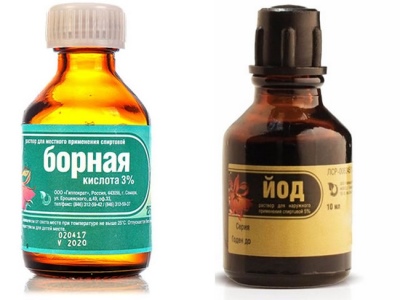
Boron helps the growth of roots, stimulates flowering and fruit formation, and in addition, prevents the provision of ovaries. Boric acid is probably the second most popular home remedy after iodine for fighting late blight and other diseases of tomatoes. Boric acid is used not only in a duet with iodine, but also "solo". Tomatoes are fed with its solution 2-3 times per summer season - in late spring or early summer for prevention, after the formation of buds and when active flowering has begun. Processing is carried out in dry weather, in the morning or in the evening.
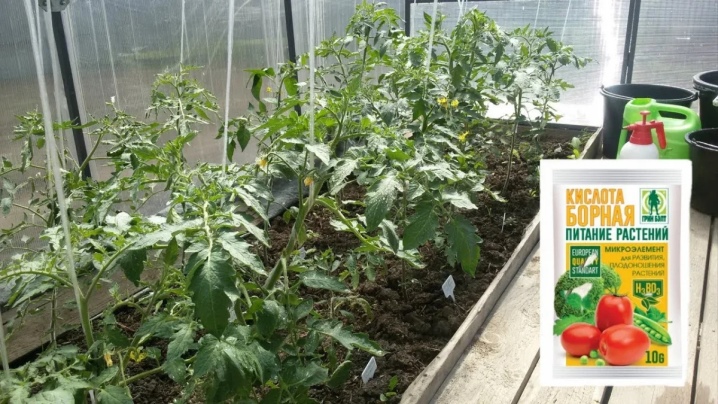
A boric acid solution for working with tomatoes is prepared in a proportion of 5 grams of active ingredient per 10 liters of water. One liter of such liquid is enough for 10 square meters of planting. For root feeding of boric acid, add 10 grams.
Attention! It is possible to add a composition with boric acid under the root only after abundant watering of the plant.
Other
The list of iodine “comrades-in-arms” in the struggle for the harvest is not limited to milk and boric acid.
Kefir
The recipe for feeding with kefir is similar to the recipe for milk. The ratio of the components is as follows: 0.5 liters of kefir, 10 liters of water, 10 drops of iodine. The uses are the same as for milk and whey.
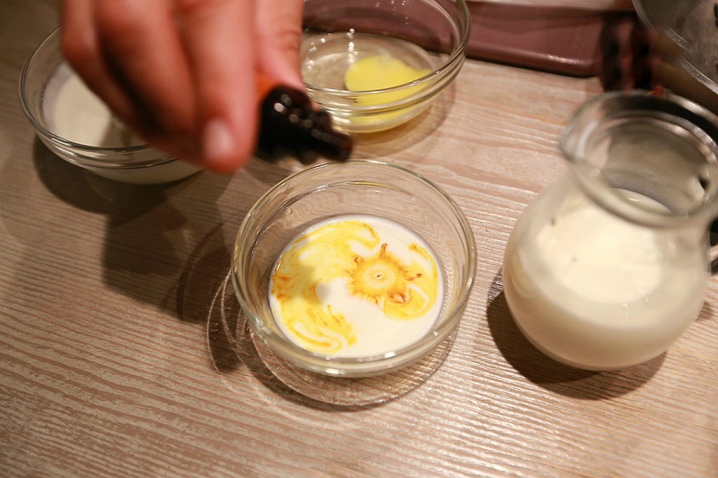
Zelenka
In the fight against late blight, brilliant green can join iodine. For 5 liters of water you need 20 drops of brilliant green and 5 iodine. It is most convenient to measure the volume of brilliant green, like iodine, with a pipette or syringe. The seedlings should be treated with the mixture two weeks after planting in the ground and the procedure should be repeated every 14 days. The method is rather ambiguous. It is not known until the end how brilliant green affects tomatoes. But everything is clear with regard to its coloring properties - traces of the preparation of the solution may remain with you for a week.

Experienced gardeners believe that treatment with iodine and brilliant green makes sense only as an additional measure, after using special preparations to combat the disease.
Potassium permanganate
You can add potassium permanganate to iodine, in the ratio of half a gram of crystals per 100 ml of the composition. Potassium permanganate is another antiseptic that works well on plants and at the same time contains potassium and manganese, which have a positive effect on their growth. As with iodine, when working with potassium permanganate, it is important to observe the proportions so as not to burn the plant.
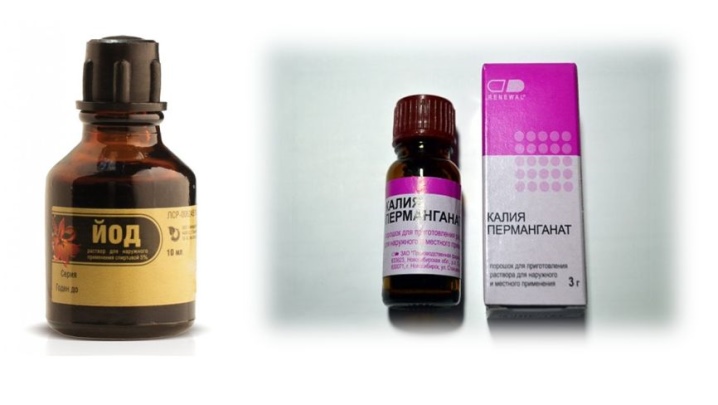
The seeds are treated with potassium permanganate, keeping them for a couple of minutes in its solution (1 gram per 1 liter of cold water) and the plants themselves are sprayed with them. They are sprayed with a light crimson or pink (by no means purple!) Solution in May-June, at the end of the first month of summer and in mid-July, if the weather is not dry. After the rain, at least a day should go at the time of processing.
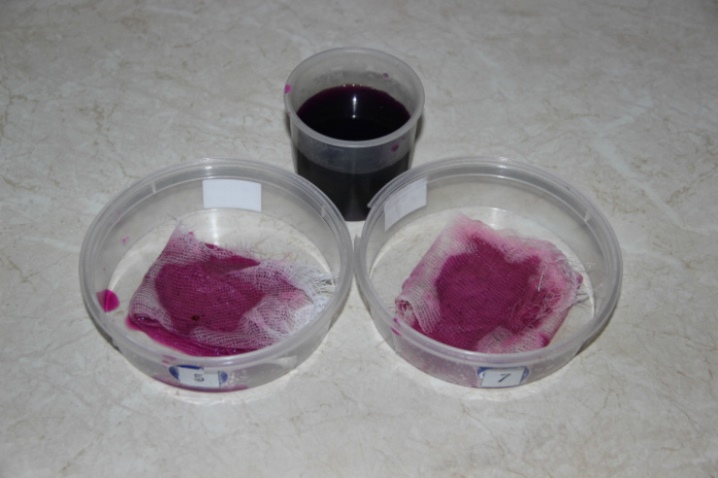
Tomato berries and leaves are treated once a week with a mixture of 3 grams of potassium permanganate per 10 liters of water. For the treatment of the disease, potassium permanganate is used in combination with garlic. 100 grams of chopped garlic bulbs are poured into a glass of water and kept in a dark place for 24 hours. Then add 1 gram of potassium permanganate. The concentrated composition is diluted in 10 liters of water and applied every 10-15 days.
Some summer residents process already harvested fruits with potassium permanganate, if there is a danger that late blight will kill them before they ripen. The collected tomatoes are kept in warm water with potassium permanganate, wrapped, after drying, with paper and left to ripen.
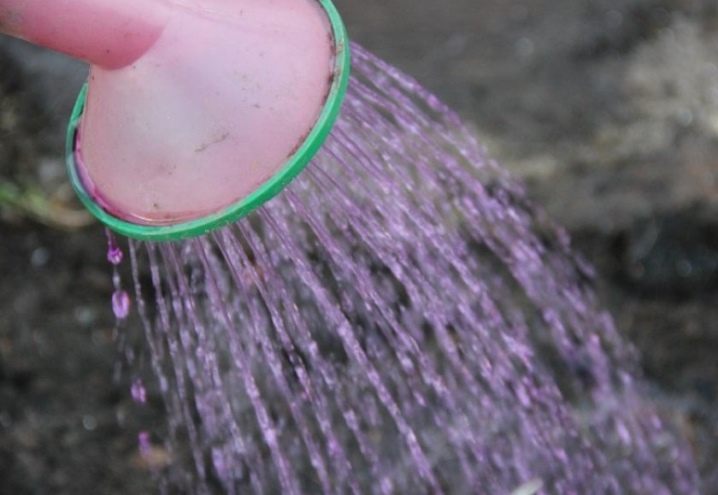
Garlic
A mixture of iodine and garlic is another home remedy for late blight. An explosive mixture is made according to the following recipe: 200 grams of water is 20 grams of iodine, 200 grams of chopped garlic or garlic arrows and 30 grams of soap. Chopped garlic is added to the water first. It should be infused for 2-3 days, after which the composition is filtered, diluted in 10 liters of water, and only then the remaining components are added. The recipe is interesting, although the large amount of iodine added confuses many gardeners.
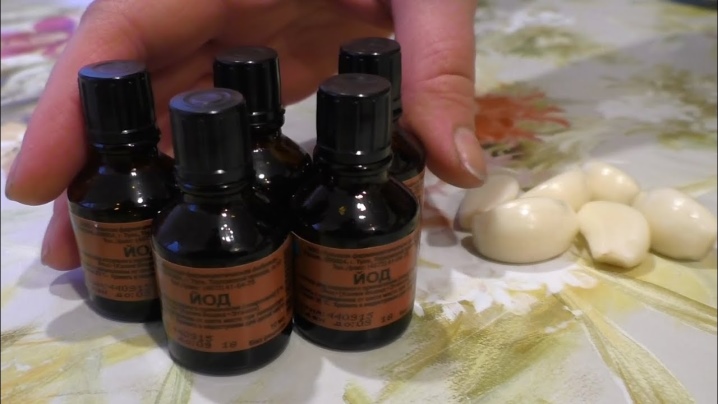
Yeast
After the beginning of the flowering period, you can combine iodine feeding of tomatoes with yeast feeding. For 5 liters of yeast solution, 3 drops of iodine are required. It is possible to prepare a yeast solution from both dry and raw yeast. Here are two recipes for a similar composition.
On dry yeast: you need 5 liters of warm (not hot!) Water, 5 grams of dry yeast, 1 tablespoon of sugar. After mixing the components, they must be left for 2-3 hours.
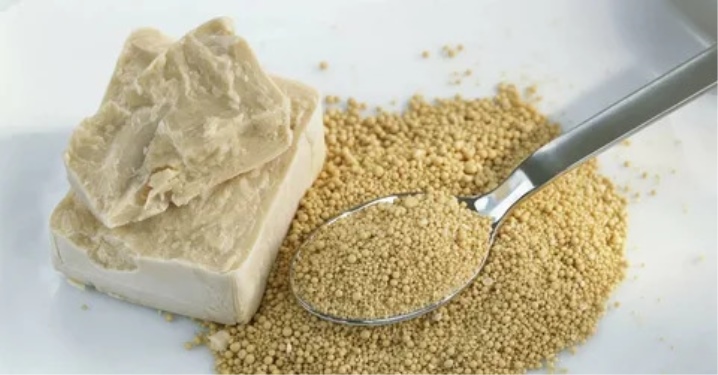
On raw yeast: you need 10 liters of heated water, 100 grams of yeast, 2 tablespoons of sugar. The composition should be infused until bubbles appear. The sugar in these blends is an optional fermentation enhancer.
It is believed that it should be used if it is planned to apply fertilizer by watering at the root, and with ordinary feeding, you can do without adding it.
Yeast is a powerful natural stimulant, generous with nutrients useful for vegetables. This product strengthens the roots and stems of tomatoes, accelerates growth and stimulates flowering.However, do not forget - excessive yeast feeding can do harm, not benefit! A significant amount of nitrogen excreted by the yeast leads to thickening of the leaves and a drop in yield. During the growth period, it is optimal to use such an additive 4 times, combining it with fertilizers rich in potassium and calcium, since these substances absorb nitrogen.

Methods and rules of introduction
Having figured out what to feed, let's move on to how to do it. Separate root and surface top dressing with iodine. To achieve maximum results, they should be alternated with each other. The root technique is better suited for seedlings - it allows you to increase the future yield of tomatoes by up to 15%. The first time the treatment is carried out after the appearance of the second pair of leaves. The second treatment is recommended at the stage of ovary formation, the third - during the fruiting period. But there is an opinion that for the period of fruit ripening, it is better to stop feeding with iodine altogether, so this is a controversial point.
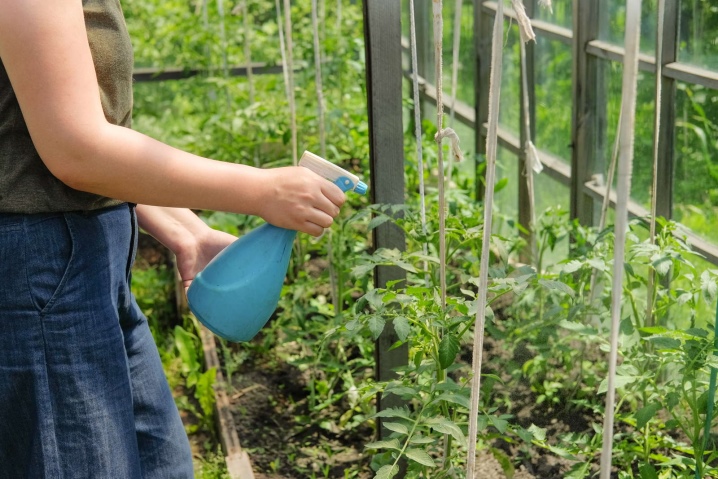
However, even seeds are treated with iodine for their preliminary disinfection. The solution for them is prepared in the ratio of a drop (0.1 g) of iodine per liter of water. A piece of gauze is moistened in the fertilizer, in which the seeds are wrapped and left for 7 hours. You do not need to rinse the seeds after the procedure, you just need to remove them in a dark place.
You can act harder, heating the solution to fifty degrees, but then only the strongest of the seeds will survive.
Watering
Before starting a conversation about watering tomatoes with compositions with iodine, let's say a few words about watering them in general, since if it is carried out incorrectly, then no additional feeding will help to get a healthy harvest. The soil for tomatoes should have a moisture content of above 80%, but you should not flood the plant either - you risk rotting the roots. Avoid watering in the sun - beams focused by drops can burn leaves.
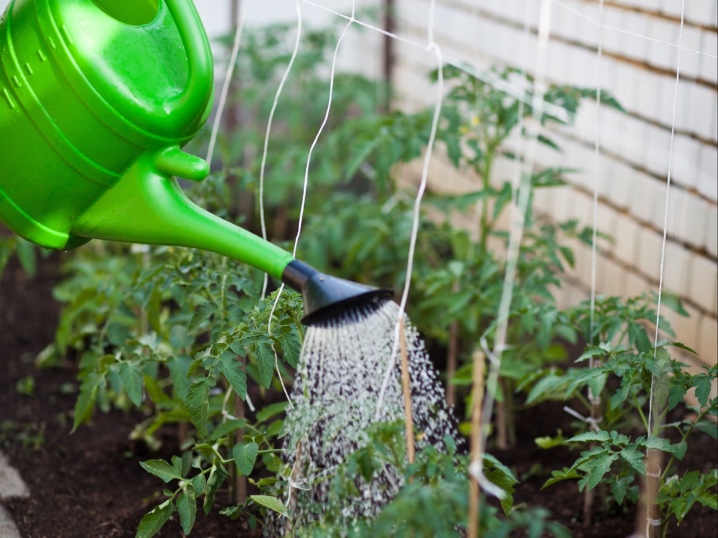
Seedlings love water at about 20 degrees Celsius; watering speeds up metabolic processes. It is best to carry out the procedure twice a day. After 15 days, you can switch to a single watering. When the tomatoes are in bloom, you can reduce the frequency of watering to a couple of three times a week, after flowering tomatoes are not so demanding for watering.
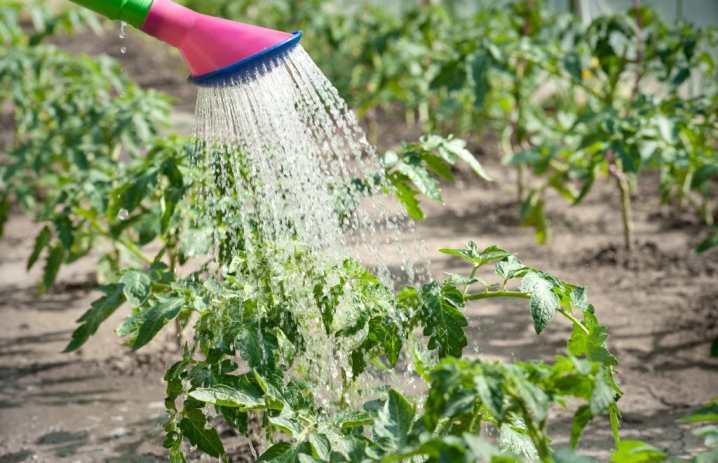
From the moment the ovary is formed, watering is carried out at the root, until a small puddle is formed. And when the fruits begin to form, they water it every day or every two days, increasing the water consumption per bush to two liters. When watering with fertilizer, it is worth remembering a few simple rules. Firstly, you cannot use cold water for this - this can cause a "shock" to the tomato root system. Secondly, it is better to water on already slightly damp soil. Thirdly, this must be done clearly at the root. The day before moving the seedlings to the beds, they need to be treated with fertilizer, abundantly watering with a solution of iodine prepared in a proportion of 3 drops per 10 liters of water - this will kill the infection that lives in the soil and help the tomatoes take root better.

Spraying
Spraying is the most popular foliar treatment of plants. For the first time, it is produced about two weeks after planting in a greenhouse. You need to spray the beds evenly, keeping the sprayer at a distance from the bushes.
The greenhouse spraying season ends in August, and outdoor plants can be safely sprayed at the end of September. In cool weather, it is better to refuse the procedure. The minimum temperature is +18 degrees.
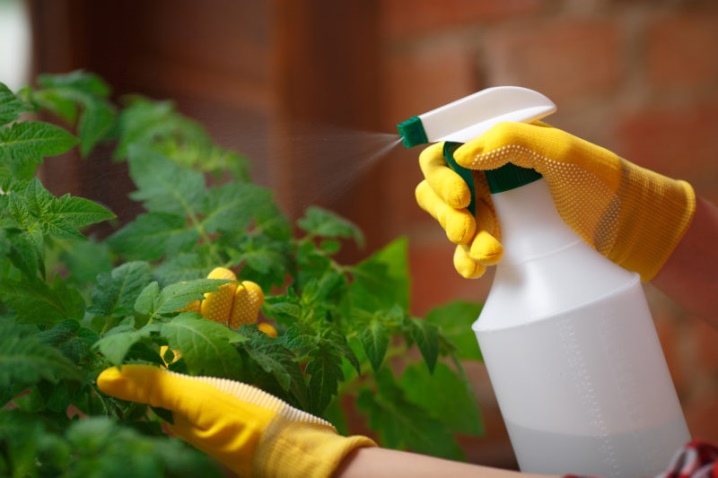
There are a couple of clever greenhouse tricks that can replace spraying. They will save you time, but they will still be weaker in efficiency. Trick one: hang an open bottle of iodine for every two square meters of the greenhouse. Do not forget that it will not be possible to stay in such a room for a long time. The second trick is to use asleep tea bags soaked in a couple of drops of iodine. They are hung in a greenhouse according to a pattern similar to bubbles.
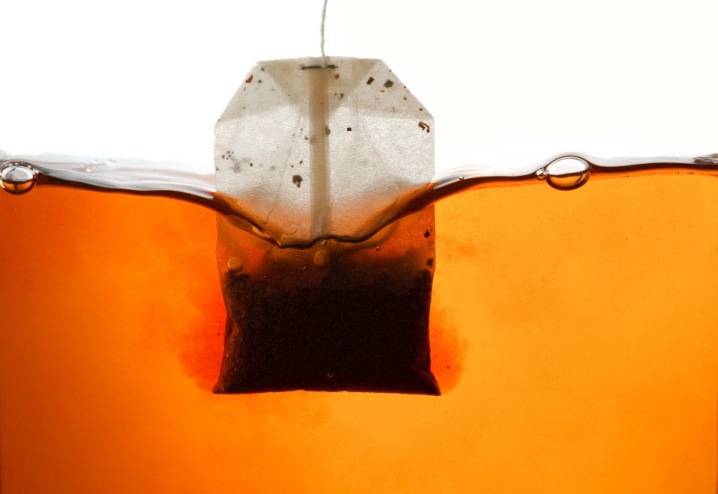
Another trick: if you add a little laundry soap to the solution, then it will not let it drain, and therefore, the efficiency will increase, and the consumption will decrease.
Precautionary measures
Everything is good in moderation. To get iodine to help your crop and not burn the plants, follow simple precautions.
- The first watering with an iodine composition should not be carried out earlier than a week after the first feeding. Water not the roots, but the ground!
- If brown spots began to appear on the leaves and fruits, you have overdone it. Only frequent and abundant watering will help to correct the situation.
- When iodine is used in a greenhouse, it must be regularly ventilated.
- Do not make a solution that is too strong, since this is a potent substance, in the indicated doses it is more than enough. If the concentration is exceeded, both the bush and you can get harm if you inhale the vapors.
- Yes, iodine is harmless in small doses, but even 3 grams of a substance that has entered the body can be fatal. Strictly follow the recipe to increase the yield, so as not to burn the plant, keep the solution out of the reach of children.
Some fear the risk of iodine accumulation in the fruit. This fear is understandable, but if the dosages are observed, the concentration of iodine in tomatoes will be (if at all - there is an opinion that iodine does not accumulate in them) scanty. In the end, we use iodized salt.
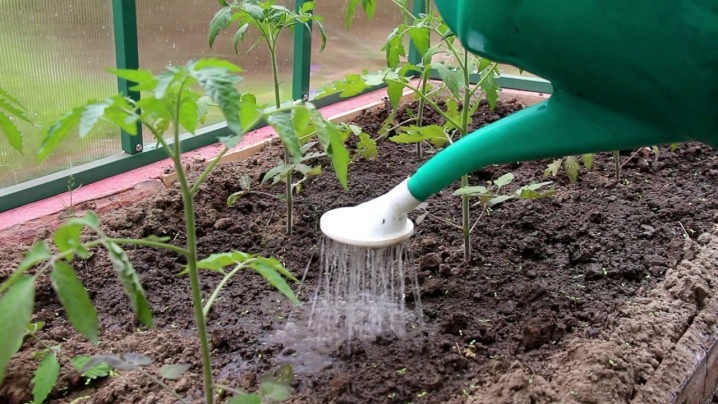













The comment was sent successfully.